Ten emerging potato pest and disease threats
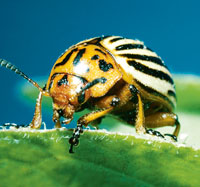
International trade and climate change are just two reasons why new potato pest and disease threats could emerge. Philip Case with the help of Gerry Saddler from Scottish government agency SASA pinpoints 10 potential threats.
Last year’s Dickeya solani outbreaks were a distinct reminder of just how easily new pest or disease threats can emerge, and how serious they could potentially be for the UK’s potato industry.
It also brought sharply into focus whether all potential threats should be given quarantine status. Dickeya solani doesn’t have that status, although many potential threats do.
Quarantine status brings the benefit of official testing, although that doesn’t guarantee infections will be picked up. For example, you need at least a 1.5% infection level to be 95% confident of picking up a disease in a 200 tuber sample. Infections of less than 1.5% could slip through, and you may be looking to pick up a 0.1% infection.
There are also serious implications for finding a quarantine pest or disease on your farm, as John Morgan found to his cost with ring rot. It means complete destruction of the infected crop, and potentially other crops, possibly losing the land to potato production, a bill to clean or disinfect machinery, storage and boxes, all without any compensation.
Quarantine measures are there to eradicate, so freedom can be maintained. Not having pests or diseases on a quarantine list, however, accepts their introduction and spread.
That’s the situation with Dickeya. It means the impact on growers will be less immediate, unless yield is badly affected, and more longer term. Once the disease gets introduced, growers have to accept yield losses and the additional control cost.
Blackleg (Dickeya solani)
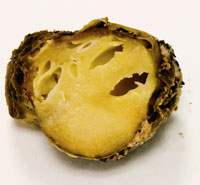 Dickeya solani is a seed-borne bacterial blackleg disease that has emerged as a major threat to potato crops in Britain and Europe. The pathogen causes plants to wilt and rot in tubers, and its symptoms are almost indistinguishable from “traditional” blackleg, Pectobacterium atrosepticum. However, the disease appears to be more aggressive and causes damage in a wider range of conditions and at lower bacterial loadings.
Dickeya solani is a seed-borne bacterial blackleg disease that has emerged as a major threat to potato crops in Britain and Europe. The pathogen causes plants to wilt and rot in tubers, and its symptoms are almost indistinguishable from “traditional” blackleg, Pectobacterium atrosepticum. However, the disease appears to be more aggressive and causes damage in a wider range of conditions and at lower bacterial loadings.
Dickeya, previously known as Erwinia chrysanthemi, was first reported in Holland in the early 1970s. Early findings were mostly Dickeya dianthicola, but in 2005, a close relative called Dickeya Solani, a new more aggressive form, was found in Holland. Losses due directly to the disease reached £22m in the country by 2007.
Dickeya has since established itself in a number of European countries, including Belgium, France, Finland, Poland and Spain. It has become the main cause of blackleg in some European countries in the past five years.
Dickeya was first discovered in England in a seed crop in North Yorkshire in 2007. Ten cases of Dickeya solani were identified in England and Wales on seed and ware crops in 2009, while two cases were found in ware crops grown from imported seed in Scotland.
From 2010, there will be zero tolerance in the Scottish Seed Potato Classification Scheme (SPCS), based on the fact that Dickeya has never been found in potatoes of Scottish origin.
Ring rot (Clavibacter michiganensis)
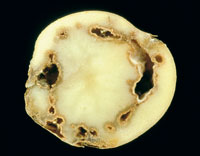 Ring rot or bacterial ring rot is one of the most feared diseases of the potato industry, especially for seed producers. The disease is caused by the bacterium Clavibacter michiganensis.
Ring rot or bacterial ring rot is one of the most feared diseases of the potato industry, especially for seed producers. The disease is caused by the bacterium Clavibacter michiganensis.
Symptoms include yellowing of the leaf margins which later turn brown and look like they are burned. Tubers rot from the inside, sometimes progressing to leave hollow shells.
In 2008-09, there were outbreaks in Germany, the Netherlands, Italy, Spain and in some eastern European countries.
Three isolated outbreaks of ring rot were found in England and Wales in 2003/04, which were eradicated and the UK still enjoys ring rot-free status.
To protect against the disease, the Safe Haven Certification Scheme was set up to reduce the risk of outbreaks and spread of ring rot and other bacterial diseases.
Brown rot (Ralstonia solanacearum)
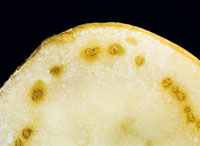 Brown rot is caused by the bacterium Ralstonia solanacearum and is widely distributed in warm, temperate areas of the world.
Brown rot is caused by the bacterium Ralstonia solanacearum and is widely distributed in warm, temperate areas of the world.
Within the EU, there have been regular findings in many countries, while there have been five outbreaks in England in ware potatoes between 1992 and 2000. The disease has never been found in Scotland. The latest outbreak in England was two months ago in the south-west, from Dutch seed, which was contained.
Symptoms include wilting of the potato plant, but the disease is most noticeable in tubers. A brown ring is found if the tuber is cut in half and in severe infections, the vascular regions rot away completely.
Colorado potato beetle (Leptinotarsa decemlineata)
 Colorado beetle was first recorded as a pest in the USA in 1859. It is widely established in much of continental Europe, having first arrived in Bordeaux in 1922, but not the UK.
Colorado beetle was first recorded as a pest in the USA in 1859. It is widely established in much of continental Europe, having first arrived in Bordeaux in 1922, but not the UK.
With climate change, the risk of it extending its range and becoming established in Britain is increasing. It may arrive in this country by “hitchhiking” in plant produce from overseas, such as potatoes and salad. It is one of the best known beetles and is famous for devouring potatoes, tomatoes, egg plants and peppers. Adult beetles as well as their larvae can strip plants of leaves and ruin an entire crop.
Dome-shaped adults are nearly 0.5in long, yellow, with five black stripes on each wing cover. The beetle has developed a resistance to all major insecticide classes used in the UK.
Flea beetle (Epitrix similaris)
Small black beetles that originated in North America, flea beetles have spread rapidly through Portugal since 2004.
The larvae cause corky lesions and superficial warty growths on potato tubers and the adults, small black beetles, cut holes in leaves. The main impact is the loss of commercial value of the tubers – damaged tubers are rejected. Yield does not appear to be affected.
The adults are active fliers and it is possible that juvenile stages or adults may be spread with tubers or soil. Potato tubers or soil attached to the tubers could carry the pest (as larvae, pupae or overwintering adults) over long distances.
Potato spindle tuber viroid (PSTVd)
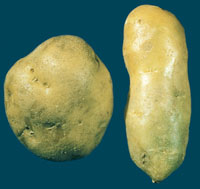 In potatoes, symptoms in the field may be difficult to recognise before plants mature. Potato plants infected with a severe infection of PSTVd are upright, stunted and much thinner than normal plants. Leaves are smaller, may be grey and twisted or distorted. Once potato plants are mature, symptoms can be clearer in tubers and affected varieties appear small, narrow and spindle-like.
In potatoes, symptoms in the field may be difficult to recognise before plants mature. Potato plants infected with a severe infection of PSTVd are upright, stunted and much thinner than normal plants. Leaves are smaller, may be grey and twisted or distorted. Once potato plants are mature, symptoms can be clearer in tubers and affected varieties appear small, narrow and spindle-like.
Yield losses of up to 64% have been recorded in potato crops infected by PSTVd. Interactions between other viruses may also occur.
Outbreaks in tomato crops have been recorded in the UK, Germany, the Netherlands, Australia and New Zealand. Seed-borne infection is the likely source of these outbreaks, although it has been difficult to confirm this.
Potato tuber moth (Phthorimaea operculella)
 The potato tuber moth is a small greyish-brown moth with narrow fringed wings and a wingspan of about 15mm. The larvae are called potato tuberworm and it is a major pest on potatoes in New Zealand, South Africa and increasingly in the USA.
The potato tuber moth is a small greyish-brown moth with narrow fringed wings and a wingspan of about 15mm. The larvae are called potato tuberworm and it is a major pest on potatoes in New Zealand, South Africa and increasingly in the USA.
Tuber moth larvae cause damage to growing plants by mining leaves in the field and infesting potato tubers held in storage.
The pest may seriously damage the commercial quality and vigour of seed potatoes and can lead to the total destruction of the stored crop.
Root-Knot Nematode (Meloidogyne chitwoodi)
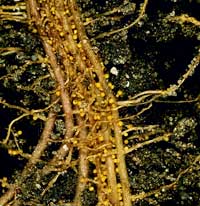 This potato pest is spreading throughout Europe, but it has never been found in Britain. It has a wide host range including grass weeds, cereals, crops and potatoes.
This potato pest is spreading throughout Europe, but it has never been found in Britain. It has a wide host range including grass weeds, cereals, crops and potatoes.
Above ground symptoms of heavily infested plants include stunting and yellowing, while below ground, galling is typical. The nematode causes the production of root-knot galls when larvae infect the plant’s roots and capture nutrients stored in the roots.
It was first isolated and characterised on potato in northern USA in 1980. Since then, it has established itself as a major multi-million pound pest on potato tubers. It has been recorded in western USA, Mexico, Argentina and South Africa, and more recently, in the Netherlands, Belgium, Germany and Portugal.
Wart disease (Synchytrium endobioticum)
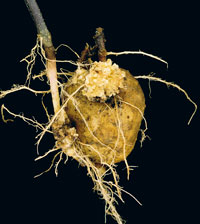 Potato wart disease is caused by a soil-borne fungus, Synchytrium endobioticum, which attacks the growing points on the potato plant, such as eyes, buds and stolon tips.
Potato wart disease is caused by a soil-borne fungus, Synchytrium endobioticum, which attacks the growing points on the potato plant, such as eyes, buds and stolon tips.
The disease poses a particular threat to potato production because the fungus can remain dormant in the soil for several years or more as resting spores.
There have been sporadic outbreaks of wart disease in Europe over the past 15 years, though none in Britain. The most recent new cases were in Turkey in 2003 and Bulgaria in 2004.
Zebra chip (psyllid)
Potatoes exposed to the Zebra chip pathogen develop unsightly black lines resembling the stripes of zebras. The disease was first identified in 1994 near Saltillo, Mexico, and was originally named “papa manchada” (stained potato).
Zebra chip has since been reported in Texas, New Zealand and Eastern Europe.
The cause of Zebra chip is unknown. Many Zebra chip symptoms are evident before the potato is even harvested; foliar signs include chlorosis, leaf scorching, swollen nodes, vascular tissue browning, and curled leaves.
Last year, the disease cost the New Zealand potato industry £18-20m.
Other potato threats
Tomato leaf miner (Tuta absoluta)
Pepino mosaic virus (Potexvirus)
Bemisia tabaci (Bt) transmitted viruses
Photography: SASA

